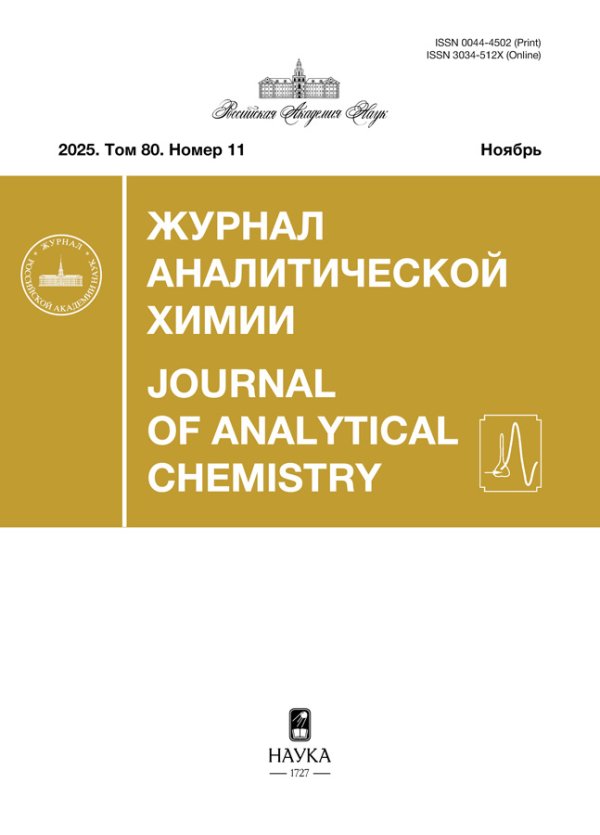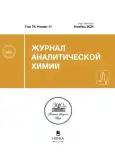Получение и оптимизация масс-спектрометрического определения персульфида глутатиона
- Авторы: Ишкаева Р.А.1, Лопухов Л.В.1, Низамов И.С.1, Абдуллин Т.И.1
-
Учреждения:
- Казанский (Приволжский) федеральный университет
- Выпуск: Том 79, № 11 (2024)
- Страницы: 1237-1245
- Раздел: ОРИГИНАЛЬНЫЕ СТАТЬИ
- Статья получена: 16.06.2025
- URL: https://vestnik.nvsu.ru/0044-4502/article/view/684633
- DOI: https://doi.org/10.31857/S0044450224110101
- EDN: https://elibrary.ru/swobts
- ID: 684633
Цитировать
Полный текст
Аннотация
Персульфид глутатиона (GSSH) является важным метаболитом клетки, участвующим в редокс-регуляции, и потенциальным терапевтическим агентом. Вследствие нестабильности и отсутствия коммерческих стандартов GSSH, актуальной задачей является разработка методик его генерации in situ и количественного определения в различных тест-системах. В работе оптимизированы условия получения GSSH в реакции окисленного глутатиона с сульфидом натрия при флуоресцентном мониторинге высвобождающегося сероводорода. Для дериватизации генерируемых GSSH и восстановленного глутатиона (GSH) с образованием близких по величине количеств обоих производных реакцию проводили в присутствии избытка N-этилмалеимида. Описана методика определения GSSH по уровню GSH в модельной реакции методом ВЭЖХ-масс-спектрометрии в режиме мониторинга множественных реакций. Установлен вклад примеси GSH в растворе окисленного глутатиона в определяемое количество GSSH и предел обнаружения GSSH в реакционной смеси. Результаты представляют интерес для получения и масс-спектрометрического анализа биологически значимых персульфидов с использованием различных дериватизирующих агентов.
Ключевые слова
Полный текст
Об авторах
Р. А. Ишкаева
Казанский (Приволжский) федеральный университет
Автор, ответственный за переписку.
Email: r.a.ishkaeva@gmail.com
Россия, ул. Кремлевская, 18, Казань, 420008
Л. В. Лопухов
Казанский (Приволжский) федеральный университет
Email: r.a.ishkaeva@gmail.com
Россия, ул. Кремлевская, 18, Казань, 420008
И. С. Низамов
Казанский (Приволжский) федеральный университет
Email: r.a.ishkaeva@gmail.com
Россия, ул. Кремлевская, 18, Казань, 420008
Т. И. Абдуллин
Казанский (Приволжский) федеральный университет
Email: r.a.ishkaeva@gmail.com
Россия, ул. Кремлевская, 18, Казань, 420008
Список литературы
- Калинина Е.В., Гаврилюк Л.А. Синтез глутатиона в опухолевых клетках // Биохимия. 2020. Т. 85. № 8. С. 1051. https://doi.org/10.31857/S0320972520080059 (Kalinina E.V., Gavriliuk L.A. Glutathione synthesis in cancer cells // Biochemistry (Moscow). 2020. V. 85. № 8. P. 895. https://doi.org/10.1134/S0006297920080052)
- Kalinina E., Novichkova M. Glutathione in protein redox modulation through S-glutathionylation and S-nitrosylation // Molecules. 2021. V. 26. № 2. Article 435. https://doi.org/10.3390/molecules26020435
- Noguchi N., Saito Y., Niki E. Actions of thiols, persulfides, and polysulfides as free radical scavenging antioxidants // Antioxid. Redox Signal. 2023. V. 39. № 10–12. P. 728. https://doi.org/10.1089/ars.2022.0191
- Benchoam D., Cuevasanta E., Möller M.N., Alvarez B. Hydrogen sulfide and persulfides oxidation by biologically relevant oxidizing species // Antioxidants. 2019. V. 8. № 2. Article 48. https://doi.org/10.3390/antiox8020048
- Iciek M., Bilska-Wilkosz A., Kozdrowicki M., Górny M. Reactive sulfur species and their significance in health and disease // Biosci. Rep. 2022. V. 42. № 9. Article BSR20221006. https://doi.org/10.1042/BSR20221006
- Vašková J., Kočan L., Vaško L., Perjési P. Glutathione-related enzymes and proteins: A review // Molecules. 2023. V. 28. № 3. Article 1447. https://doi.org/10.3390/molecules28031447
- Fukuto J.M., Hobbs A.J. A comparison of the chemical biology of hydropersulfides (RSSH) with other protective biological antioxidants and nucleophiles // Nitric Oxide. 2021. V. 107. P. 46. https://doi.org/10.1016/j.niox.2020.11.004
- Takata T., Jung M., Matsunaga T., Ida T., Morita M., Motohashi H., et al. Methods in sulfide and persulfide research // Nitric Oxide. 2021. V. 116. P. 47. https://doi.org/10.1016/j.niox.2021.09.002
- Zhou B., Xiao J.F., Tuli L., Ressom H.W. LC-MS-based metabolomics // Mol. BioSyst. 2012. V. 8. № 2. P. 470. https://doi.org/10.1039/C1MB05350G
- Ida T., Sawa T., Ihara H., Tsuchiya Y., Watanabe Y., Kumagai Y., et al. Reactive cysteine persulfides and S-polythiolation regulate oxidative stress and redox signaling // Proc. Natl. Acad. Sci. U. S.A. 2014. V. 111. № 21. P. 7606. https://doi.org/10.1073/pnas.1321232111
- Kasamatsu S., Owaki T., Komae S., Kinno A., Ida T., Akaike T., Ihara H. Untargeted polysulfide omics analysis of alternations in polysulfide production during the germination of broccoli sprouts // Redox Biol. 2023. V. 67. Article 102875. https://doi.org/10.1016/j.redox.2023.102875
- Sutton T.R., Minnion M., Barbarino F., Koster G., Fernandez B.O., Cumpstey A.F., et al. A robust and versatile mass spectrometry platform for comprehensive assessment of the thiol redox metabolome // Redox Biol. 2018. V. 16. P. 359. https://doi.org/10.1016/j.redox.2018.02.012
- Bailey T.S., Zakharov L.N., Pluth M.D. Understanding hydrogen sulfide storage: Probing conditions for sulfide release from hydrodisulfides // J. Am. Chem. Soc. 2014. V. 136. № 30. P. 10573. https://doi.org/10.1021/ja505371z
- Lin V.S., Lippert A.R., Chang C.J. Cell-trappable fluorescent probes for endogenous hydrogen sulfide signaling and imaging H2O2-dependent H2S production // Proc. Natl. Acad. Sci. U. S.A. 2013. V. 110. № 18. P. 7131. https://doi.org/10.1073/pnas.1302193110
- Sitdikova G.F., Fuchs R., Kainz V., Weiger T.M., Hermann A. Phosphorylation of BK channels modulates the sensitivity to hydrogen sulfide (H2S) // Front. Physiol. 2014. V. 5. Article 431. https://doi.org/10.3389/fphys.2014.00431
- Pan J., Carroll K.S. Persulfide reactivity in the detection of protein S-sulfhydration // ACS Chem. Biol. 2013. V. 8. № 6. P. 1110. https://doi.org/10.1021/cb4001052
- Benchoam D., Semelak J.A., Cuevasanta E., Mastrogiovanni M., Grassano J.S., Ferrer-Sueta G., et al. Acidity and nucleophilic reactivity of glutathione persulfide // J. Biol. Chem. 2020. V. 295. № 46. P. 15466. https://doi.org/10.1074/jbc.RA120.014728
- Francoleon N., Carrington S., Fukuto J. The reaction of H2S with oxidized thiols: Generation of persulfides and implications to H2S biology // Arch. Biochem. Biophys. 2011. V. 516. № 2. P. 146. https://doi.org/10.1016/j.abb.2011.09.015
- Sun X., Berger R.S., Heinrich P., Marchiq I., Pouyssegur J., Renner K., et al. Optimized protocol for the in situ derivatization of glutathione with N-ethylmaleimide in cultured cells and the simultaneous determination of glutathione/glutathione disulfide ratio by HPLC-UV-QTOF-MS // Metabolites. 2020. V. 10. № 7. Article 292. https://doi.org/10.3390/metabo10070292
- Thakur S.S., Balaram P. Fragmentation of peptide disulfides under conditions of negative ion mass spectrometry: Studies of oxidized glutathione and contryphan // J. Am. Sos. Mass Spectrom. 2008. V. 19. № 3. P. 358. https://doi.org/10.1016/j.jasms.2007.12.005
- Yu B., Yang X., Yuan Z., Wang B. Prodrugs of sulfide and persulfide species: Implications in their different pharmacological activities // Curr. Opin. Chem. Biol. 2023. V. 75. Article 102329. https://doi.org/10.1016/j.cbpa.2023.102329
Дополнительные файлы














